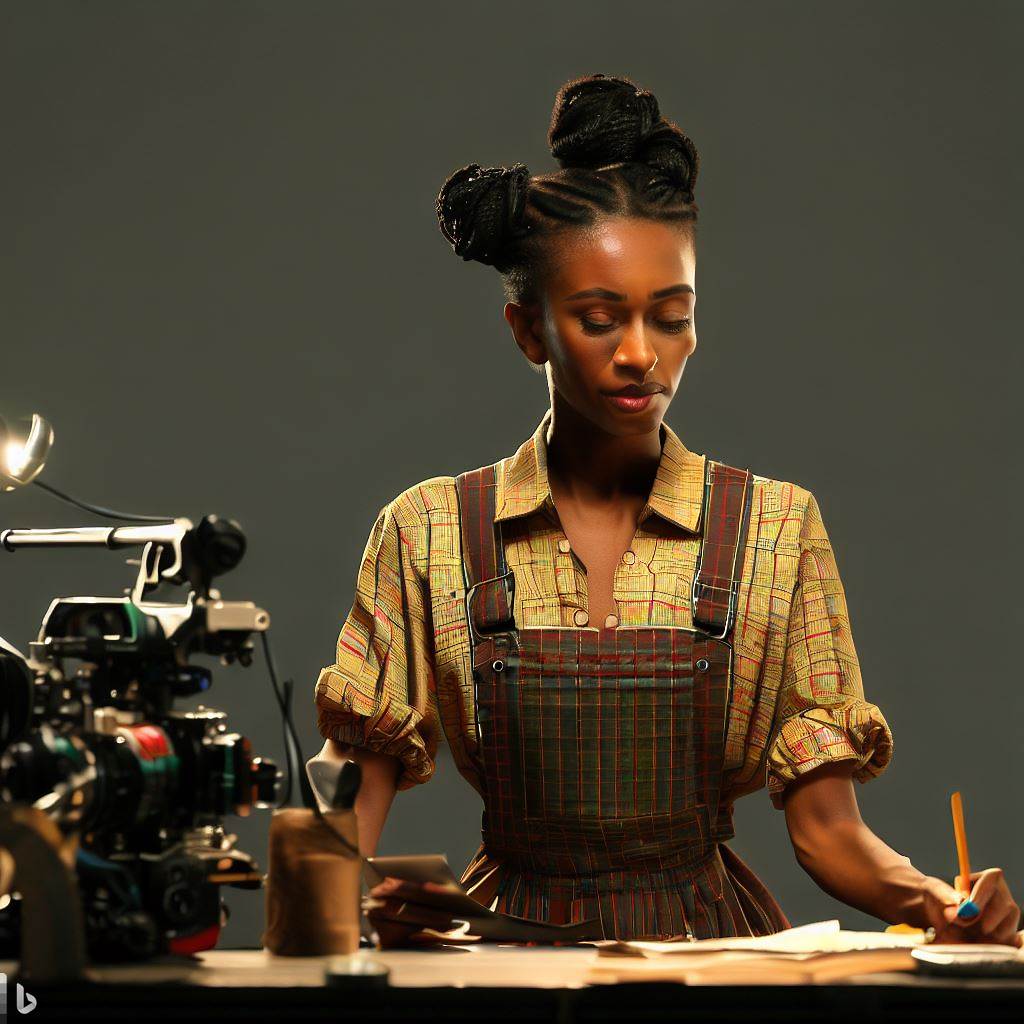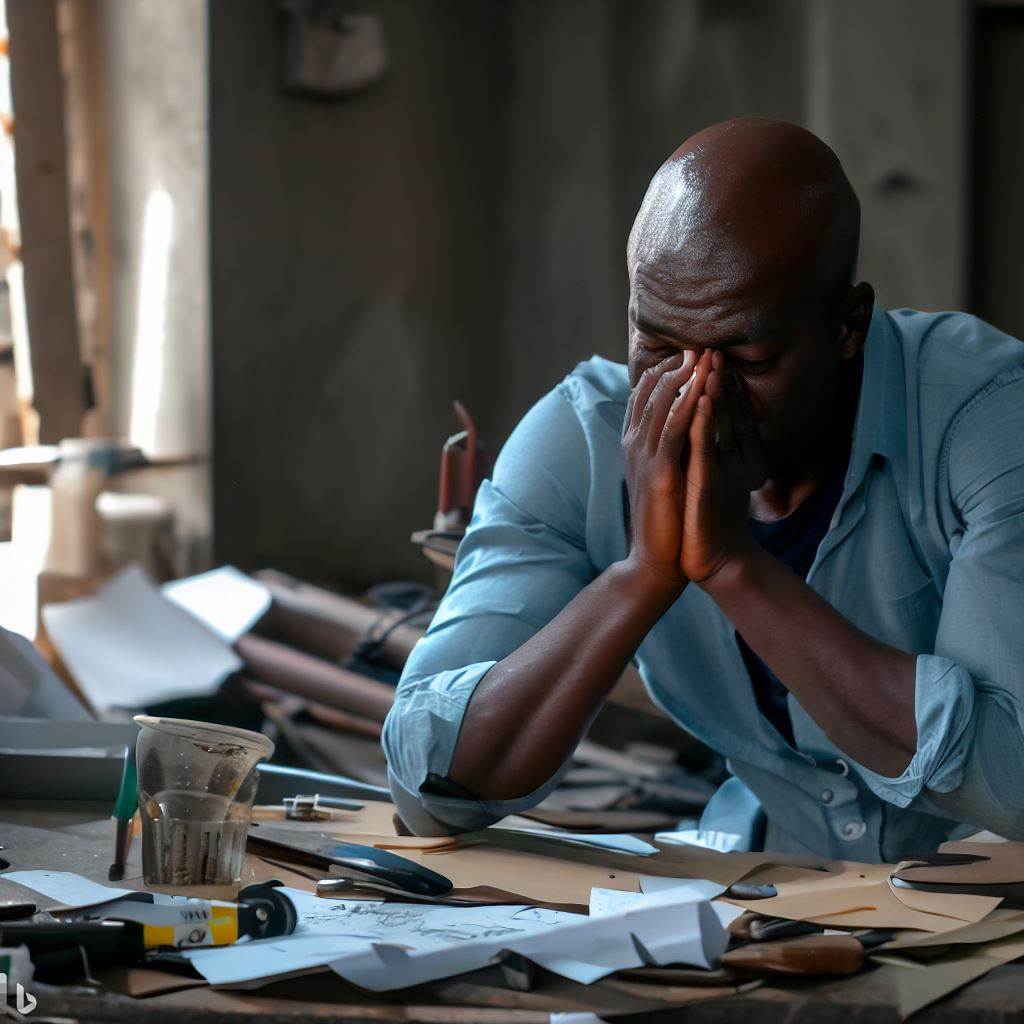Introduction
A. Introduction to Nigeria’s production design
Nigeria, also known as the “Giant of Africa,” is not only renowned for its rich cultural heritage but also for its vibrant and growing film industry, referred to as Nollywood.
Within Nollywood, production design plays a crucial role in creating visually captivating and immersive storytelling experiences.
B. Brief overview of job outlook and trends in the field
The job outlook for production designers in Nigeria is promising, as the film industry continues to thrive and expand both domestically and internationally.
With the increasing demand for high-quality content, there is a growing need for skilled professionals who can transform scripts into visually appealing and engaging narratives.
In recent years, there have been noticeable trends in Nigeria’s production design field. One of the key trends is the shift towards more realistic and immersive production designs.
Filmmakers are investing in creating authentic settings that reflect the local culture and environment, enhancing the audience’s experience.
Moreover, technological advancements have had a significant impact on production design.
The availability of advanced tools and software has empowered designers to create visually stunning and intricate sets with greater ease and efficiency.
This trend has elevated the overall production quality and raised the bar for creativity in the field.
Another notable trend is the emphasis on sustainability in production design.
There is a growing awareness of the environmental impact of filmmaking, leading to the adoption of eco-friendly practices.
Designers are incorporating sustainable materials and implementing efficient construction methods to reduce waste and minimize carbon footprint.
As Nigeria’s film industry continues to evolve, the job outlook for production designers remains promising.
The trends mentioned above indicate the industry’s commitment to enhancing the visual storytelling experience, creating opportunities for talented individuals to thrive and contribute to the growth of Nigeria’s production design sector.
Overview of Nigeria’s Production Design Industry
A. Definition of production design and its significance
Production design refers to the process of creating the visual look and feel of a film, television show, or theater production.
It plays a crucial role in storytelling, as it helps to establish the setting, mood, and atmosphere of a project.
The production design industry in Nigeria is vital for bringing stories to life, as it involves choosing and arranging the sets, props, costumes, and overall aesthetic elements that enhance the narrative.
B. Historical background of production design in Nigeria
The history of production design in Nigeria can be traced back to the early days of the Nigerian film industry, commonly known as Nollywood.
In its early stages, the industry lacked proper structure and relied on low-budget productions. Consequently, production design was often overlooked, resulting in unimpressive visuals.
However, with the growth and popularity of Nollywood, the importance of production design became evident.
Filmmakers realized that investing in high-quality visuals could enhance the overall viewing experience and attract a larger audience.
As a result, the industry began to adopt more professional production design practices.
C. Current state of the industry
1. Growth and development
In recent years, the Nigerian production design industry has experienced significant growth and development.
The demand for visually appealing and well-designed films has increased, leading to a rise in the number of production design professionals and companies.
With advancements in technology and access to better resources, production designers now have the tools they need to create visually stunning productions.
This has not only improved the quality of Nigerian films but has also allowed the industry to compete on a global level.
2. Major players and companies
Several major players and companies have emerged in the Nigerian production design industry.
These professionals and organizations are dedicated to pushing the boundaries of creativity and ensuring that their productions stand out.
One notable production design company is The Bloom Room, which has worked on numerous successful Nigerian films.
Their innovative and meticulous approach to production design has earned them accolades and recognition both locally and internationally.
In addition, individual production designers such as Wunmi Ayodeji and Osagie Samuel have made significant contributions to the industry.
Their unique styles and attention to detail have elevated the visual appeal of their respective projects.
Overall, the Nigerian production design industry has come a long way and continues to evolve.
As the demand for captivating visuals in film and television increases, production designers have the opportunity to shape the future of storytelling in Nigeria.
Through their creativity and expertise, they are instrumental in creating immersive and memorable experiences for audiences.
Read: Production Design in Nollywood: A Career Insight
Job outlook in Nigeria’s production design
A. Demand for Production Designers
- Nigeria’s booming film and television industry continues to fuel the demand for skilled production designers.
- The surge in local content production has created a pressing need for creative design professionals.
- Advertising agencies, event planners, and architectural firms also seek production design expertise.
B. Opportunities for Career Growth
- Aspiring production designers can kickstart their careers as assistants or interns in production companies.
- Earning experience by working on diverse projects allows for skill development and networking.
- Advancement opportunities include becoming senior designers, art directors, or establishing independent design studios.
C. Factors Affecting Job Prospects
1. Impact of the Entertainment Industry
- Nigeria’s entertainment industry drives production design, with Nollywood leading the way.
- Collaborations with international studios expand opportunities for exposure and recognition.
2. Technological Advancements
- Proficiency in design software like AutoCAD and 3D modeling tools enhances competitiveness.
- Adapting to emerging technologies like virtual reality opens new avenues in design.
3. Government Support and Policies
- Government incentives and grants encourage the growth of creative industries.
- Clear copyright and intellectual property laws protect designers’ rights, boosting confidence.
Basically, Nigeria’s production design sector is on an upward trajectory, offering abundant opportunities.
The entertainment industry’s surge, coupled with technological advancements and government support, fosters a promising outlook.
Aspiring designers should focus on skill development and stay abreast of industry trends to thrive in this dynamic field.
Read: Ethics and Best Practices: Production Design in Nigeria
Current trends in Nigeria’s production design
A. Fusion of traditional and modern elements in design
- The contemporary production design in Nigeria combines traditional African aesthetics with modern influences.
- This fusion creates unique and innovative designs that reflect Nigeria’s rich cultural heritage.
- Designers incorporate traditional motifs, patterns, and materials into modern furniture, clothing, and accessories.
- The combination of traditional and modern elements in design showcases Nigeria’s ability to blend the old and the new.
- This trend appeals to both local and international audiences, contributing to the growth of the design industry in Nigeria.
B. Role of cultural diversity in shaping designs
- Nigeria’s cultural diversity plays a significant role in shaping its production designs.
- The country is home to over 250 ethnic groups, each with its distinct cultural heritage and design aesthetics.
- Designers draw inspiration from these diverse cultures, incorporating their unique elements into their creations.
- Traditional Nigerian clothing, jewelry, and artwork have gained international recognition and popularity.
- This emphasis on cultural diversity in design promotes inclusivity and celebrates Nigeria’s multicultural identity.
C. Influence of international collaborations and exposure
- International collaborations have had a profound impact on Nigeria’s production design industry.
- Designers are increasingly partnering with international brands and individuals, bringing fresh perspectives and ideas.
- These collaborations provide exposure for Nigerian designers on a global scale, expanding their market reach.
- Exposure to international design trends and practices stimulates innovation and creativity in the Nigerian design industry.
- Nigeria’s growing presence in international design exhibitions and events has further cemented its reputation as a design hub.
Generally, Nigeria’s production design is experiencing a dynamic phase marked by the fusion of traditional and modern elements.
Cultural diversity plays a crucial role in shaping designs, while international collaborations and exposure contribute to innovation and global recognition.
This vibrant mix of influences showcases Nigeria’s rich cultural heritage and its ability to adapt and thrive in the global design landscape.
Read: Networking for Production Designers in Nigeria

Skills and Qualifications Necessary for a Career in Production Design
A. Technical Skills in Design Software and Equipment
- Proficiency in design software such as Adobe Creative Suite, AutoCAD, and 3D modeling programs.
- Knowledge of lighting techniques and the ability to use them effectively in design projects.
- Familiarity with video editing software and the ability to create visually captivating multimedia content.
- Experience in using design equipment such as cameras, projectors, and sound systems.
- Ability to troubleshoot technical issues that may arise during production and find creative solutions.
B. Creativity and Artistic Abilities
- In-depth understanding of design principles and the ability to apply them in unique and innovative ways.
- Strong visual and spatial awareness, allowing for the creation of aesthetically pleasing and functional designs.
- Ability to conceptualize and visualize ideas, translating them into tangible design elements.
- Proficiency in sketching, drawing, and other forms of visual communication to convey design concepts.
- Capability to adapt to various styles, genres, and themes, catering to the specific needs of each project.
C. Communication and Collaboration Skills
- Effective verbal and written communication skills to convey design ideas and concepts to clients and team members.
- Strong interpersonal skills to build positive working relationships and collaborate with a diverse range of individuals.
- Active listening abilities to understand client requirements and incorporate feedback into the design process.
- Leadership skills to effectively coordinate and manage design teams, ensuring the smooth execution of projects.
- Flexibility and adaptability to work in a fast-paced, collaborative environment, adjusting to changing project needs.
D. Educational Background and Training Options
- Bachelor’s degree in design, visual arts, film, or related fields is commonly preferred by employers.
- Pursuing additional certifications and training programs in design software and techniques can enhance job prospects.
- Participation in internships or apprenticeships can provide practical experience and industry connections.
- Continuous learning and staying updated with emerging design trends and technologies are essential.
- Developing a portfolio showcasing past design projects and highlighting diverse skills and abilities is crucial.
Essentially, a career in production design requires a combination of technical skills, creativity, communication, and collaboration abilities.
The proficiency in design software, the ability to think creatively, and strong communication skills play a significant role in succeeding in this field.
Additionally, a relevant educational background, continuous learning, and building a strong portfolio are vital for career advancement in production design.
By cultivating these skills and qualifications, aspiring professionals can unlock diverse job opportunities and contribute to Nigeria’s thriving production design industry.
Read: Apprenticeships in Production Design in Nigeria
Challenges and Opportunities in Nigeria’s Production Design Industry
A. Lack of Local Infrastructure and Resources
- Limited access to sophisticated production equipment and technology hinders the industry’s development.
- The insufficient number of production studios and specialized training centers restricts skill development.
- Challenges in sourcing high-quality raw materials locally result in reliance on imports, increasing production costs.
- Inadequate support from the government in terms of policies and incentives for production design services.
B. Competition from Foreign Designers
- Established international production design firms attract clients with their reputation and expertise.
- Foreign designers often have access to advanced technologies, giving them a competitive edge.
- Their portfolio of successful projects creates a perception that they are more reliable and capable.
- Foreign designers may have a better understanding of global design trends, catering to diverse client demands.
C. Potential for Growth and Innovation in the Digital Age
- The rise of digital platforms creates opportunities for Nigerian production designers to showcase their work globally.
- Online marketplaces enable designers to reach international clients and expand their customer base.
- With increased internet penetration, designers can collaborate remotely, enhancing project efficiency.
- Technological advancements like virtual reality and augmented reality offer new possibilities for creative presentation and visualization.
Despite the challenges faced by Nigeria’s production design industry, there are significant opportunities for growth and innovation.
With the right strategies and support, local designers can overcome these hurdles and thrive in a competitive market.
D. Factors to Propel Success
- Government Support: Implementing policies that provide incentives, subsidies, and infrastructure development assistance.
- Skill Enhancement: Establishing training programs and specialized institutions to nurture local talent.
- Collaboration: Building partnerships between local and international designers to exchange knowledge and expertise.
- Market Expansion: Leveraging digital platforms to access global markets and attract international clients.
- Innovation: Embracing technological advancements to transform production design processes and offer unique solutions.
Nigeria’s production design industry faces formidable challenges posed by a lack of local infrastructure, competition from foreign designers, and limited resources.
However, by focusing on skill development, embracing innovation, and leveraging digital platforms, the industry can overcome these obstacles and seize the opportunities presented by a rapidly evolving global market.
With the necessary support from the government and collaboration among industry stakeholders, Nigeria’s production design industry has the potential to thrive and make a significant contribution to the country’s creative economy.
Explore Further: Spotlight on Top Nigerian Designers: Who’s Shaping the Future?
Conclusion
A. Recap of key points discussed
In this blog post, we explored Nigeria’s production design industry and its job outlook and trends.
We discussed the importance of production design in Nigeria and its impact on the entertainment industry.
We also highlighted the emerging opportunities and potential growth in the field.
B. Importance of production design in Nigeria
Production design plays a crucial role in the success of Nigerian movies, TV shows, and other forms of media.
It encompasses the visual elements that create the overall look and feel of a production, including set design, props, costumes, and visual effects.
A well-executed production design enhances storytelling, immerses the audience in the narrative, and adds value to the production.
C. Optimistic outlook for the future of the industry
The Nigerian production design industry is experiencing a positive trajectory.
With the increasing demand for quality content both domestically and internationally, there are abundant opportunities for talented production designers in Nigeria.
As the entertainment industry continues to thrive and evolve, production design will continue to be a vital aspect that drives creativity, innovation, and audience engagement.
In a nutshell, Nigeria’s production design industry holds immense potential and promises a rewarding career path for aspiring designers.
The industry’s growth, coupled with the appreciation for Nigerian art and culture worldwide, opens doors for professionals to showcase their skills and contribute to the development of the entertainment landscape.
As Nigeria’s film and television industry expands, production design will play an increasingly important role in shaping the visual identity and narratives of Nigerian productions.




